The things we record and why - part two
We are no longer building saddle trees, but we have two videos about how Western saddles fit horses available on our westernsaddlefit.com website.
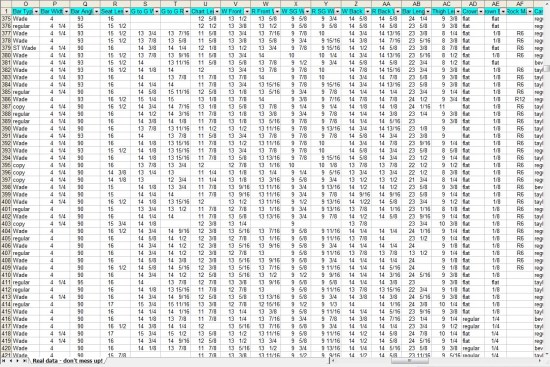
The next thing down our list, after the fork measurements, are bar specs and information on fitting the horse. We keep track of measurements for ourselves that never go out to the saddle makers. Why not? It probably isn't useful for them to know, and it isn't something anyone can use in comparing between different saddle makers anyway. But for us, for our trees, where we know exactly what we do to build them, these measurements are very useful for our own learning purposes.
Bar type
When we talk about bar type, we are talking primarily about outline patterns. All the other factors that affect fit - crown, rock, twist, length, etc. etc. can vary regardless of outline pattern. While we do have combinations of these which we commonly use together to fit the different body types, those things can go with either outline pattern. So we could label this column "bar outline pattern", but that makes the heading in my database too long...
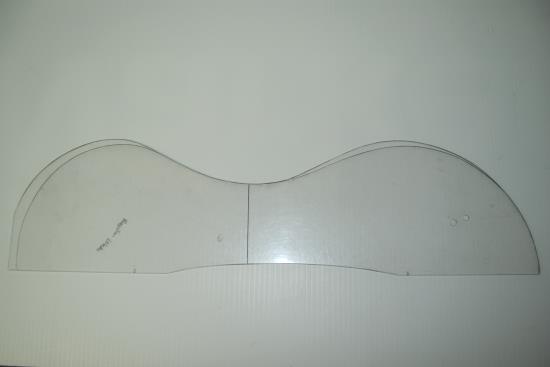
We have only two main outline patterns we use regularly, the "regular" and the "Wade". The difference is that the Wade is 1/4" wider (deeper) than the regular at the front and back bar pads, and it is 1/2" longer ahead of the fork cut to give us enough room for the thicker stock on Wade trees. We use the Wade bars for trees with stock thicknesses 4 1/2" or more, and the regular pattern for stock thicknesses 4 1/4" or less. Pretty basic.
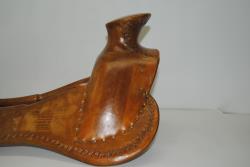 |
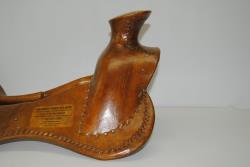 |
Then there are the exceptions... For the more heavily muscled body type of horse, that extra length on the Wade bar tip can be an issue so we will use the Wade bar outline but shorten the tip to the regular length. Thus "ST Wade", for short tip Wade, gets entered into the database. We make more of a back cut on the gullet lip to give the saddle maker enough room on the bar ahead of the fork for his concho when we short tip a Wade bar.
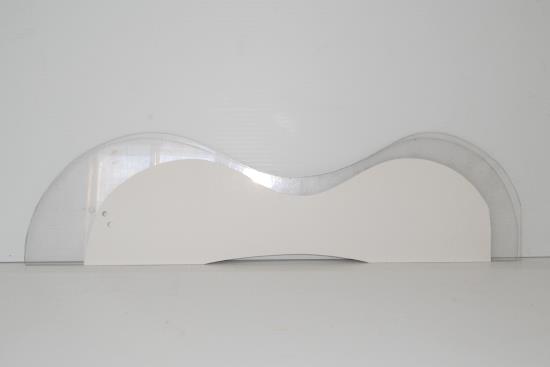
We have also come up with a kid's pattern for much smaller bars for the itty-bitty kiddie trees we get ordered. (Rod is building another one of these this week, actually.) It is only 5" behind the cantle cut compared to the normal 6", but has the normal 5" ahead of the fork cut. Its bar depth is also about an inch less than our regular bar outline pattern. When we have compared this pattern to some of the trees we have in to duplicate, we have found that what we have for our kid's bar is pretty much the amount of surface area available on some other trees as their full sized bar. Interesting...
Then there are the others... Ones we just label "copy", since we have to make the outline shape the same as the original tree in order to fit the bars back into the old leather. And a few variations here and there for special requests. Just to keep things interesting...
Bar width, or bar spread
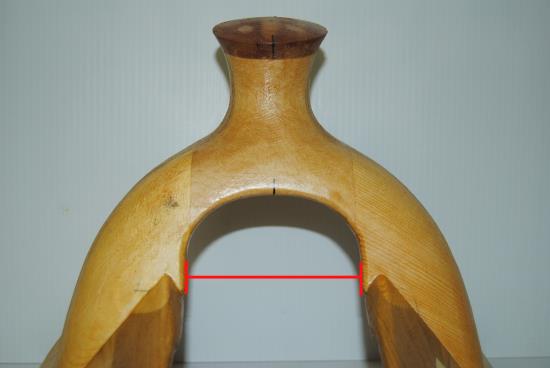
This is the measurement at the back of the hand hole which is how we, and all other hand made tree makers we know, set the distance between the bars. A common measurement people use instead of hand hole width is gullet width. We have never actually measured or recorded the gullet width on our trees, so when people ask about it, that is one of the very few things (maybe the only one?) we can't tell you. We didn't start measuring it because we weren't using it, and we have never yet found a useful reason to measure it, so we don't. Why not? I could explain it all here, but why repeat what I already wrote? You can check out our Why We Use Hand Hole Width Instead of Gullet Width page to find out.
Bar angle
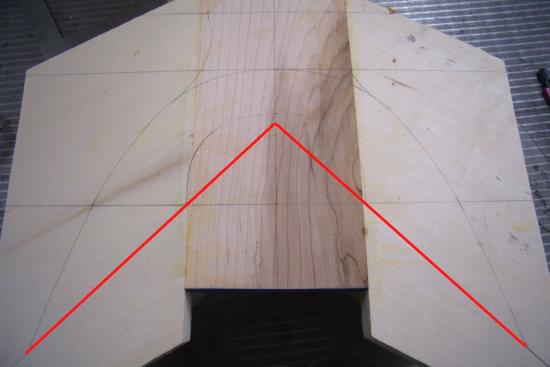
Why am I showing you a picture of the fork when we are talking about bars? Because it is the angle we draw on the fork that sets the angle of the bars. Our most common bar angle is still 90 degrees. Just over half the trees we now build are at 90 degrees. The second most common angle we use is 93 degrees, which makes up the majority of the remainder.
Then there are the others... We have been making more at 95 degrees lately, and they are working well on these big, larger muscled horses that have been becoming more common, even on working ranches. We have made a few at 98 degrees and a couple even wider for really flat backed horses. And we have made one (so far) at 87 degrees, which apparently used to be a very common angle when horses were narrower with steeper withers. Looking back, there were a few others that maybe we could have made at 87 degrees. Live and learn...
I need to repeat again here that you can't compare the "angles" between makers by just a number. There are too many differences in how bars are made to have a measurement define the "angle" and expect different maker's bars to fit the same. I won't repeat why because I explained it all in our Bar Angles: Why the Numbers Are Meaningless Between Makers page, but it is an important concept to grasp. The numbers themselves really don't mean a lot between makers.
Width across the front of the bars
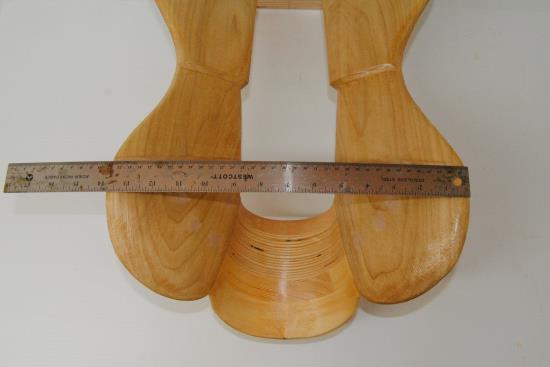
Something we have measured from the beginning is the width across the bottom of the front of the bars at the widest point. We use it to compare the effect of different bar spreads and angles. This measurement changes equally with changes in bar spread, so 1/4" difference in hand hole width results in 1/4" difference across the front of the bottom of the bars. But it took recording lots of measurements and then checking back to see how the different bar angles affect it. Now we can say for sure that changing from a 90 to a 93 degree bar makes 1/8" difference across the bottom of the bars for our regular bar outline pattern (and a bit more for the Wade, only because the bars are deeper). We also used our records of these measurements to figure out that when you change the fork angle and nothing else, it really does change the fit for the horse. And then we used them to help us figure out how much we had to change things to compensate for different fork angles and still get the same "across the bottom of the bar" measurement. That in itself made doing all these measurements worth while.
However, we can't compare "fit" by using this measurement, because bar depth makes a difference. For example, since our Wade bars are deeper than our regular bars, the front measurement is about 1/2" wider on Wade bars than regular ones with the same bar spread and angle. This demonstrates one of the reasons you definitely can't use this measurement to compare fit between makers - all the bar depths are different.
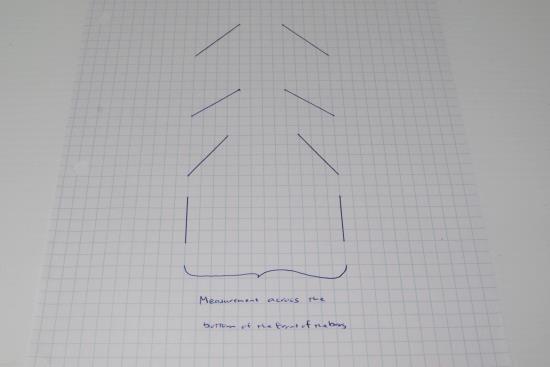
Another reason you cannot use only this measurement to compare fit between makers is that it tells us nothing about the angle of the bars, and that is really important. As the picture above tries to demonstrate, you can have the same measurement across the bottom of the bars and yet have dramatically different hand hole widths and bar angles, and of course the fit will be totally different. Comparing within one maker's trees where they keep their bar angles and bar depth consistent, this can be used. Between tree makers - no way.
Width across the middle of the bars
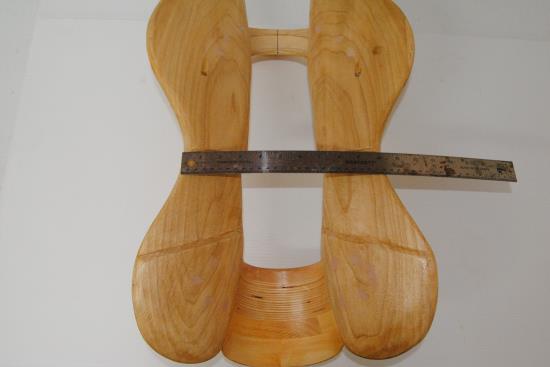
We also measure across the back of the stirrup groove, which is the narrowest place on tree bars. We try to keep this measurement as consistent as possible between all the different fits so for a wider fit, the bar itself will be a bit narrower. We also narrow it when asked, but there is a limit to how narrow we will make the bar itself. Thus for trees to go on really wide horses, this measurement will be wider than normal. The debate rages as to how important it is to get the tree narrow here when it is the width of the horse, not the saddle, that hold the rider's legs apart anyway.
Something we have discovered using the Dennis Lane system is that a lot of bars are very steep compared to the horses' back shapes at this point. Most of our Quarter Horse types flatten out quite quickly. (In other words, the twist starts fairly far forward.) By keeping the bars angled more steeply here, it helps the saddle maker put in a narrower seat for the rider. But the angle of the bars also has to match the angle of the horse's back all the way along to fit well. This is where the comfort of the rider versus the horse can come in. Tree and saddle makers have to recognize what is happening and adjust their designs to work well for both, but to the detriment of neither.
Width across the back of the bars
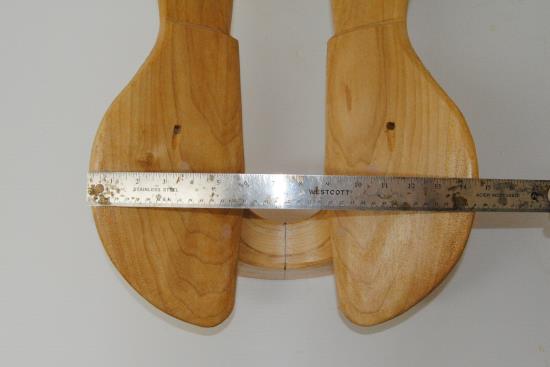
We didn't start out measuring across the middle or across the back of the bars, but eventually we clued in that this information would help us learn more about how changes in the way the bar was made affects twist. The bar outline pattern we use, the bar width and the bar angle all affect this measurement the same way they do for the front measurement and so again, this measurement is meaningless between makers. But for us, it is an important tool.
We record all three of the "across the bottom of the bar" measurements in both the wood and the rawhide. Why? We measure in the wood because the measurements in the wood are more consistent, not affected by the different thicknesses of rawhide. Those are the measurements we use when trying to figure out something. We measure in the rawhide because that is what will go on the horse, and it also that tells us how much difference the rawhide makes in different places. It is interesting how much thinner it measures over a sharper angle, like at the back of the bars, than over a rounder one, like at the front of the bars.
Bar length
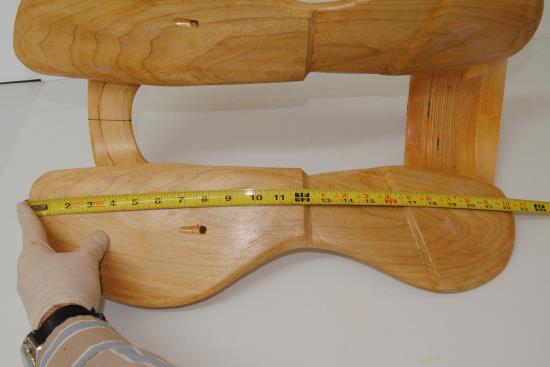
We measure how long the bar is tip to tip, along the curve of the bar, with a tape measure and we do this in both the wood and the rawhide.
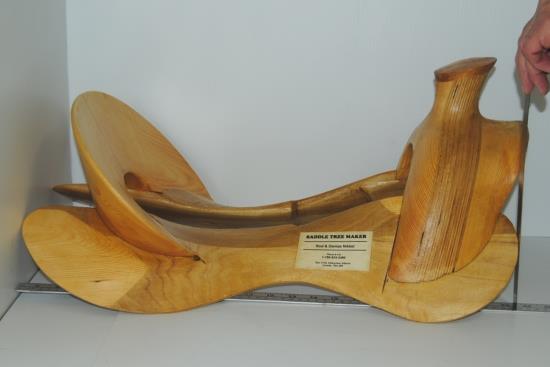
Some people also measure bar length on the flat as in the picture above. Doing it our way makes the measurement 3/8" to 1/2" longer than the other way. So which way is better? Probably neither - they are just different. Doing it our way is faster and easier, and we have always been consistent in the way we measure.
We have used the measurements in our database to figure out bar lengths compared to thigh length (which is a consistent measurement - well, so long as you have the same fork angle and cantle type, of course!) and I can figure that one out in my head now. We have also been able to compare bar length to seat length, but I need our charts to check to tell you what that one is. Knowing this helps a lot in figuring out the best way to get the size needed for the rider when dealing with short backed horses who need shorter bars.
Crown - front and back
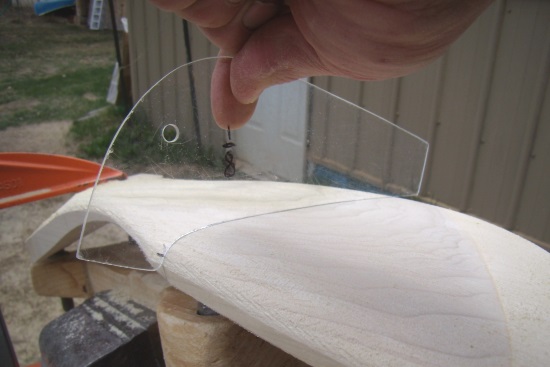
This isn't something we measure, but it is something we record. We have two main crown patterns for the front bar pad and three for the back. We use different patterns based on the rest of the fitting specs. For example, most horses needing wider and flatter bars have bulgier muscles, so we use a flatter crown pattern for those trees. Most horses with narrower bar spreads and steeper angles also have more concave withers, so we use our rounder (not round, just rounder than flatter) crown patterns on those trees.
Rock
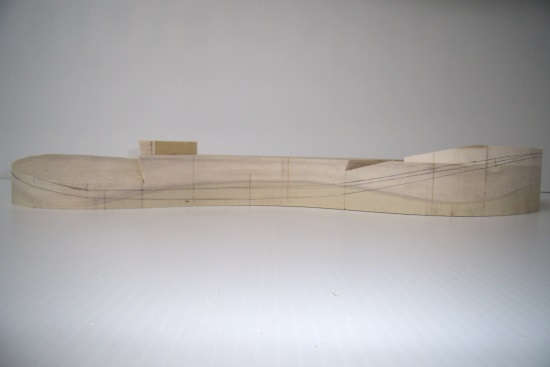
This again is something not measured but recorded. Rod sets the rock by how he marks out the edges of the bars. We now record this pretty much according to the Dennis Lane system as R3, R6, R9 or R12.
So between measurements in wood and rawhide, front and back, it takes 13 columns in our database to record. Recording the info for the rider, on the other hand, only takes up four columns, but I'll talk about them another time...
